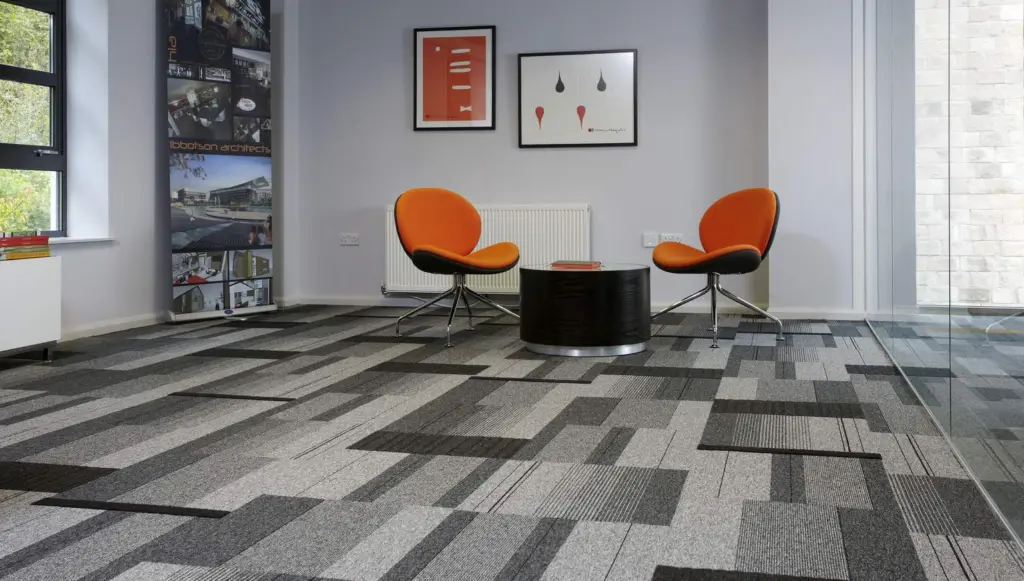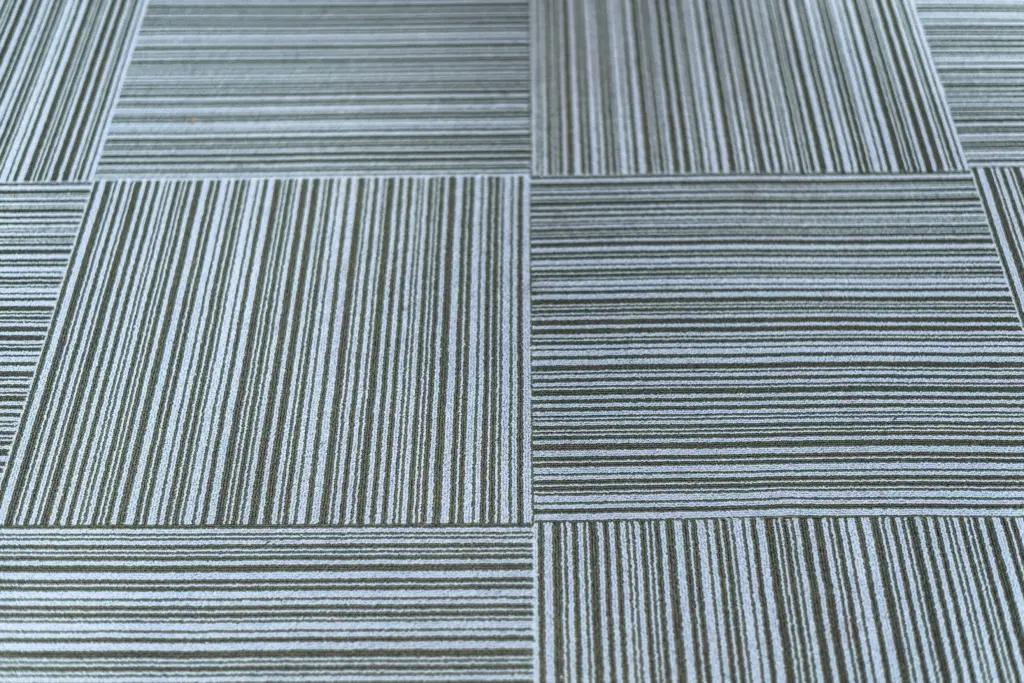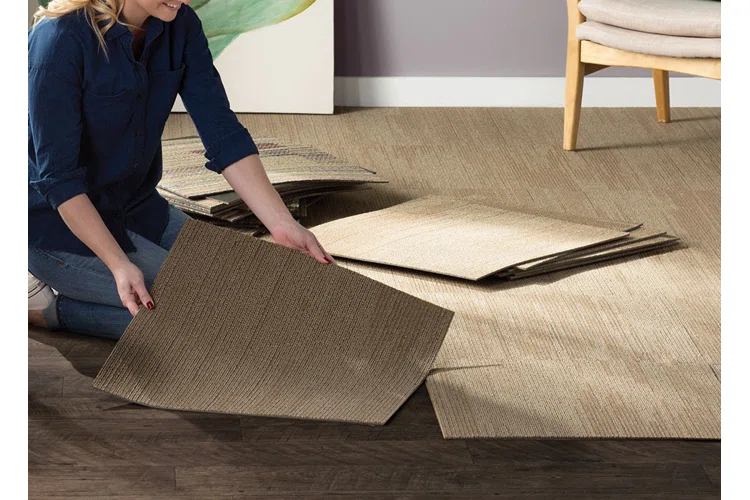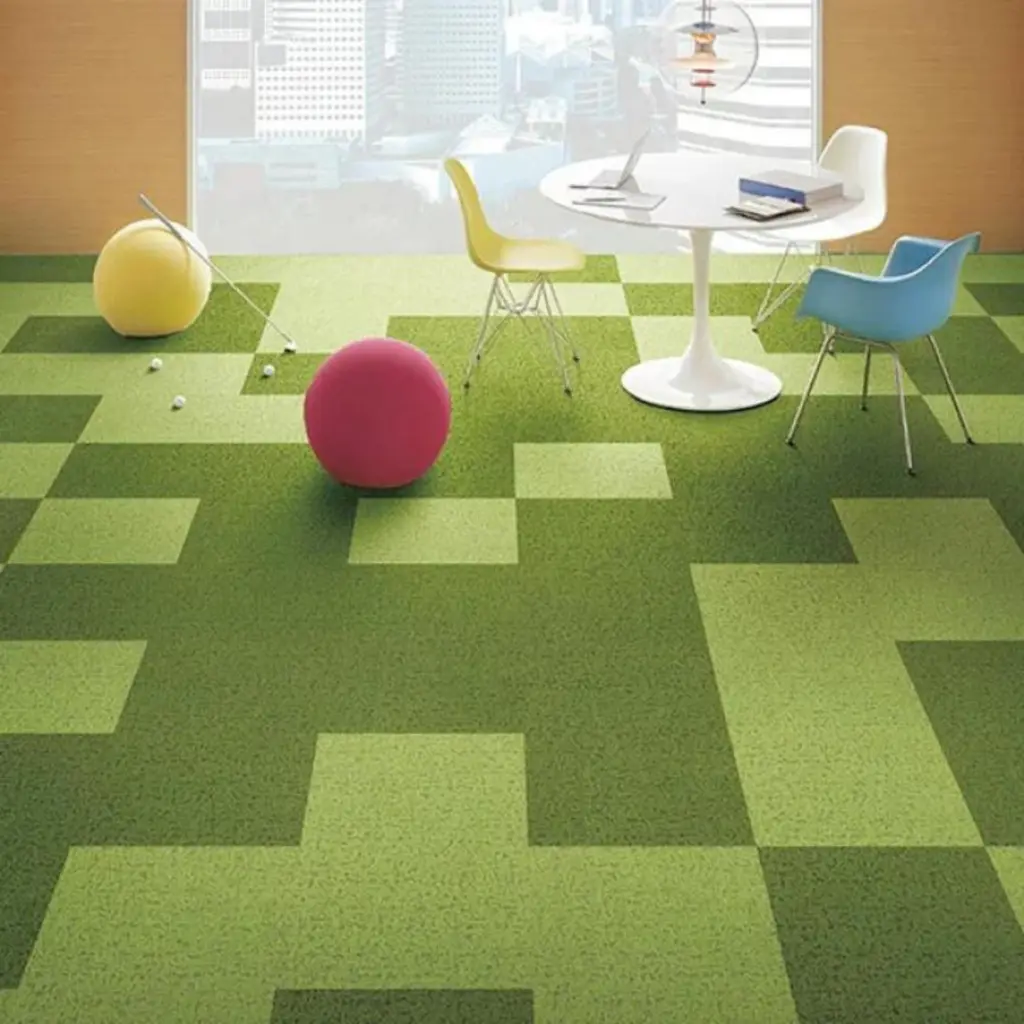Carpet Tiles: The Ultimate Guide to Practical Flooring Solutions
What are Carpet Tiles?
Carpet tile, also known as modular carpets or carpet squares, are pre-cut sections of carpet that can be easily arranged and installed on a variety of surfaces. They come in a wide range of materials, including nylon, polyester, and wool, and are available in various sizes and shapes, such as squares, rectangles, and even hexagons.
With endless design possibilities, tiles can be mixed and matched to create unique patterns and layouts that cater to individual tastes and styles.
History and Evolution of Carpet Tile


The history and evolution of carpet tile can be traced back to the mid-20th century. While traditional carpets have been in use for centuries, carpet tiles emerged as a more practical and versatile flooring solution in response to the growing demand for modular and flexible design options.
Inception in the 1950s:
Carpet tiles were first introduced in the late 1950s by a Dutch company called Heuga, founded by Petrus Johannes van Heugten.
Van Heugten recognized that cutting carpet into smaller, manageable pieces could offer a more convenient and customizable flooring solution. He developed the first tiles using a needle punch production technique, which involved mechanically intertwining fibers to create a durable and compact material.
Adoption in commercial settings:
Initially, carpet tiles gained popularity in commercial spaces, such as offices and retail stores, due to their durability and ease of installation. Their modular nature allowed for quick and simple replacement of damaged or worn tiles, reducing maintenance costs and downtime.
Material advancements:
Over time, carpet tile manufacturing techniques evolved, and new materials were introduced. Nylon became a popular choice due to its durability, stain resistance, and colorfastness. Other materials, such as polyester and wool, also gained traction, providing consumers with a wider range of options to suit their specific needs and preferences.
Design innovations:
As the technology progressed, manufacturers began experimenting with different shapes, sizes, and patterns to offer even greater design flexibility. This led to the development of various tile shapes, including rectangles, hexagons, and irregular forms, which allowed for more intricate and unique patterns.
Growing residential market:
In the late 20th and early 21st centuries, carpet tiles began to find their way into residential settings, as homeowners recognized the benefits of their easy installation, maintenance, and design versatility. The residential market’s growth further spurred innovation in the industry, resulting in a wider range of textures, patterns, and colors to suit diverse home environments.
Eco-friendly developments:
As environmental concerns have become increasingly prominent, the carpet industry has embraced sustainability. Many manufacturers now offer eco-friendly tiles made from recycled materials, such as post-consumer plastic bottles and reclaimed carpet fibers. Additionally, some companies have implemented sustainable production processes to reduce their environmental impact.
Technological advancements:
The carpet tile industry continues to evolve, with technological advancements leading to improved backing materials, enhanced stain resistance, and added features like antimicrobial and antistatic properties. These innovations contribute to the overall performance, longevity, and appeal of carpet tiles in various settings.
Benefits of Carpet Tile
The benefits of carpet tile have contributed significantly to their popularity in recent years. Their easy installation, versatility, simple maintenance, eco-friendliness, and cost-effectiveness have made them an attractive choice for various residential and commercial applications.
In this section, we will explore these benefits in detail, providing facts and examples to illustrate the reasons behind the rising popularity of tiles.
Easy installation
These tiles are designed for easy installation, often requiring minimal tools and no professional assistance, making them an ideal choice for DIY enthusiasts. The convenience of installing tiles without professional help can save homeowners and businesses both time and money.
According to the World Floor Covering Association (WFCA), carpet tiles can be installed up to 50% faster than traditional broadloom carpet (source: https://wfca.org/carpet-tiles).
Versatility
One of the most significant selling points of carpet tiles is their design versatility. They come in various materials, sizes, shapes, colors, and patterns, allowing users to create customized looks that suit their individual tastes and preferences.
For instance, Interface’s “Human Connections” collection features carpet tiles with unique patterns and textures that can be combined to create a visually appealing and functional space (source: https://www.interface.com/US/en-US/campaign/human-connections).
The Installation Process


Easy maintenance
Carpet tile is known for ease of maintenance, as individual tiles can be removed and replaced if they become damaged or stained. This feature eliminates the need to replace an entire carpet due to a single blemish.
A study conducted by Milliken found that 77% of facility managers preferred carpet tiles over traditional carpets for their ease of maintenance.
(source: https://www.millikencarpet.com/en-US/insights/carpet-tiles-benefits).
Eco-friendliness
As consumer awareness of environmental issues grows, many carpet manufacturers have adopted sustainable practices, using recycled materials and implementing environmentally responsible production processes.
For example, Interface’s “ReEntry” program focuses on recycling carpet tiles to reduce waste and promote a circular economy, while Shaw Contract’s “EcoWorx” backing is fully recyclable and Cradle to Cradle Certified.
(source: https://www.interface.com/US/en-US/about/mission/ReEntry, https://www.shawcontract.com/en-us/products/environmental).
Cost-effectiveness
While the initial cost of carpet tile may be slightly higher than traditional carpets, their longevity, durability, and ease of maintenance can make them a more cost-effective option in the long run. The ability to replace individual tiles instead of an entire carpet can lead to significant savings over time.
A study by the International Facility Management Association (IFMA) found that the life cycle cost of carpet tiles is approximately 25% lower than traditional broadloom carpets.
(source: https://www.ifma.org/publications/fmj-magazine/article/view/id/4054).
As more people become aware of these advantages and seek innovative flooring solutions, carpet tile is likely to continue gaining traction in the market.
Detailed Installation Process for Carpet Tiles in Commercial and Residential Projects
The installation process is relatively similar for both commercial and residential projects. However, commercial installations may require additional considerations, such as accommodating heavy foot traffic or adhering to specific industry standards. Here is a detailed description of the installation process for carpet tiles in both settings:
Floor preparation
Before beginning the installation, ensure that the subfloor is clean, dry, and level. Remove any debris or dust, and repair or fill in any cracks or uneven areas. If there are moisture issues, address them before proceeding with the installation. In commercial settings, it’s essential to use a moisture barrier or vapor retarder to prevent moisture-related problems in the future.
Acclimate the carpet tiles
Allow the tiles to acclimate to the room’s temperature and humidity for at least 24 hours before installation. This step helps minimize potential issues with expansion and contraction, ensuring a successful installation.
Plan the layout
Measure the room and determine the optimal starting point for the installation. Ideally, this should be the center of the room or an area where any partial tiles will be least noticeable. Sketch your desired layout, considering any patterns or designs you wish to create with the tiles. In commercial installations, make sure to consider traffic flow and any specific industry requirements.
Apply a chalk line
Using a chalk line, create reference lines on the subfloor to guide the installation. Snap lines perpendicular to each other, creating a grid pattern that corresponds with the size and shape of your tiles.
Dry fit the carpet tiles
Before adhering the tiles to the floor, lay them out according to your plan, making any necessary adjustments to ensure proper alignment and fit. This step is especially crucial in commercial settings, where intricate patterns or logos may be incorporated into the design.
Install the carpet tiles
Starting at your predetermined point, begin installing the tiles using the appropriate adhesive method. This may involve peel-and-stick backing, adhesive glue, or an interlocking system. Ensure that the tiles are properly aligned and firmly pressed onto the subfloor for optimal adhesion. In commercial settings, it’s particularly important to use a high-quality adhesive to withstand heavy foot traffic.
Cut and trim tiles as needed
As you reach the edges of the room or any obstacles, such as doorways or columns, use a carpet knife or utility knife to cut and trim the tiles to fit. Measure and mark the tile carefully before cutting, ensuring a precise fit.
Roll the carpet tiles
Once all the tiles are installed, use a carpet roller or a similar tool to press the tiles firmly into the adhesive, ensuring proper bonding. This step is particularly important in commercial installations, where heavy traffic may cause tiles to shift or lift if not adequately secured.
Post-installation care
Vacuum the newly installed tiles to remove any dust or debris. Establish a regular cleaning and maintenance routine, including vacuuming, spot cleaning, and occasional deep cleaning with a carpet cleaner designed for modular carpets.
By following these instructions, you can ensure a successful and long-lasting installation in both residential and commercial projects. Remember to consult the manufacturer’s guidelines for specific installation and care instructions, as these may vary depending on the product.
Popular Carpet Tile Brands and Manufacturers
Some of the top brands include Interface, FLOR, Shaw Contract, and Milliken. These manufacturers offer a wide range of quality products at various price points, allowing consumers to find the perfect tiles to suit their needs and budget.
When comparing brands, consider factors such as design options, material quality, and eco-friendliness to make an informed decision.
Carpet Tile Applications
A Closer Look at Versatile Flooring Solutions
In this section, we’ll explore the diverse uses of carpet tiles and how they can enhance different environments.
Residential Applications
Carpet tiles offer homeowners a unique way to customize their living spaces while ensuring comfort and durability. Below are some common residential applications:
Living Rooms:
Carpet squares can create a cozy and inviting atmosphere in living rooms, offering a comfortable surface for family gatherings and relaxation. With numerous design options available, homeowners can personalize their living spaces to match their style and preferences.
Bedrooms:
Carpet tiles are an excellent choice for bedrooms, providing warmth and sound insulation. They can also be used to create custom area rugs or wall-to-wall carpeting that adds a touch of luxury and comfort.
Home Offices:
Modular carpets can help create a productive and comfortable workspace in home offices. They provide noise reduction and can be easily replaced in case of spills or stains, making them a practical choice for work areas.
Playrooms and Children’s Bedrooms:
Carpet tiles are a popular option for playrooms and children’s bedrooms due to their easy maintenance and versatility. They can withstand heavy foot traffic and play, and damaged tiles can be replaced individually without the need to replace the entire flooring.
Basements:
Modular carpets can transform damp or cold basements into warm and inviting spaces. Opt for moisture-resistant carpet tiles and ensure proper subfloor preparation to prevent mold and mildew growth.
Commercial Applications
Carpet squares are an ideal choice for commercial spaces due to their durability, easy maintenance, and design versatility. Some of the commercial applications include:
Offices and Co-working Spaces:
Carpet squares can create a professional and inviting environment in office settings, helping to improve employee comfort and productivity. Their noise reduction properties make them an excellent choice for busy workplaces, while their design flexibility allows for the creation of distinct zones and pathways.
Retail Stores:
Carpet tiles can enhance the ambiance of retail stores by adding color, texture, and comfort underfoot. They can withstand high foot traffic, making them a practical solution for busy retail environments.
Hospitality Industry (Hotels, Restaurants, etc.):
Carpet squares offer a stylish and durable flooring option for hotels, restaurants, and other hospitality establishments. They can be used to create unique and eye-catching patterns that elevate the overall design of the space while providing comfort and noise reduction for guests.
Educational Institutions:
Modular carpets are a popular choice for schools, universities, and other educational facilities due to their durability and low-maintenance nature. They offer sound insulation, making them ideal for classrooms, libraries, and study areas, and can be easily replaced if damaged or stained.
Healthcare Facilities:
Tiles with antimicrobial properties and stain resistance are suitable for healthcare environments, such as hospitals and clinics. They offer a comfortable and quiet surface that can help reduce stress for patients and staff while being easy to maintain and clean.
Troubleshooting Common Carpet Tile Issues
Lifting and curling edges
If you notice that the edges of your carpet tiles are lifting or curling, it could be due to various factors such as inadequate adhesive, excessive moisture, or uneven subflooring. To address this issue, first determine the cause and then proceed with the appropriate solution:
Inadequate adhesive:
Remove the affected tiles, apply additional adhesive, and reinstall the tiles. Ensure that the adhesive is evenly spread and that there is proper contact between the tile backing and the subfloor.
Excessive moisture:
Identify the source of moisture (e.g., humidity, leaks) and address the issue. It may be necessary to replace affected tiles, install a moisture barrier, or use a dehumidifier to maintain optimal conditions.
Uneven subfloor:
Level the subfloor by filling any low spots with a leveling compound and sanding high spots, then reinstall the affected tiles.
Repairing or replacing damaged tiles
Carpet tiles can become damaged due to heavy foot traffic, spills, or moving furniture. To repair or replace a damaged tile, follow these steps:
Remove the damaged tile by carefully lifting it from the adhesive or interlocking system.
Clean the subfloor underneath, removing any adhesive residue or debris.
If the tile is repairable (e.g., small stain, minor tear), clean or mend the tile following the manufacturer’s guidelines. If the tile is beyond repair, replace it with a new one.
Install the repaired or new tile, ensuring proper alignment with adjacent tiles and secure adhesion to the subfloor.
Dealing with stubborn stains and odors
Stubborn stains and lingering odors can detract from the appearance and freshness of your carpet tiles. To tackle these issues:
Identify the source of the stain or odor and address the underlying cause (e.g., pet accidents, food spills).
Spot clean the affected area using a carpet cleaner specifically designed for modular carpets. Follow the manufacturer’s instructions for proper use and application.
If necessary, remove the affected tile and clean it more thoroughly or replace it with a new one.
Preventing mold and mildew growth
Mold and mildew can develop in carpet tiles due to moisture, poor ventilation, or organic material buildup. To prevent these issues:
Ensure proper ventilation in the space by opening windows, using exhaust fans, or employing a dehumidifier.
Regularly clean your carpet tiles to remove dirt, debris, and potential organic material that can encourage mold growth.
Address any moisture issues promptly, such as leaks, spills, or high humidity levels.
Prolonging carpet tile lifespan
To extend the life of your carpet tiles, consider the following tips:
Rotate tiles periodically to distribute wear evenly across the floor, especially in high-traffic areas.
Use protective mats or pads under heavy furniture to prevent indentations or damage to the tiles.
Regularly clean and maintain your carpet tiles according to the manufacturer’s recommendations. This includes vacuuming, spot cleaning, and occasional deep cleaning.
Avoid dragging furniture or heavy objects across the tiles, as this can cause damage or dislodging. Instead, lift and move items carefully or use furniture sliders.
Carpet Tile Trends and Innovations
The carpet tile industry has experienced significant growth and innovation in recent years, driven by evolving consumer preferences and technological advancements. Here are some notable trends and innovations in carpet tile design and manufacturing:
Biophilic design elements
Biophilic design, which incorporates elements of nature into interior spaces, has gained popularity in recent years. Carpet manufacturers have embraced this trend by offering designs that mimic natural materials, such as wood, stone, and grass, as well as patterns inspired by organic forms and textures.
Geometric patterns
Geometric patterns have emerged as a popular trend in carpet design. These patterns can range from simple, minimalist lines to more complex, intricate shapes. By combining different geometric designs, homeowners and designers can create eye-catching and dynamic floor coverings that add visual interest to a space.
Customization through digital printing
Digital printing technology has revolutionized carpet tile design by enabling manufacturers to produce highly detailed and vibrant patterns with virtually no limitations on color or complexity. This innovation allows for increased customization, as consumers can now choose from an extensive library of designs or even create their own unique patterns.
Improved acoustic properties
Noise reduction is a crucial factor in many residential and commercial environments, and carpet tile manufacturers have responded by developing products with enhanced acoustic properties. New innovations in backing materials and tile construction have resulted in carpet tiles that effectively absorb sound. Thus they minimize noise transmission between spaces.
Increased focus on sustainability
The carpet tile industry has made significant strides in embracing sustainability, with many manufacturers now offering products made from recycled materials, such as post-consumer PET bottles or reclaimed carpet fibers. Additionally, some companies have adopted manufacturing processes that minimize waste and reduce energy consumption, contributing to a more eco-friendly industry overall.
Smart carpet tiles
Technology has also made its way into the carpet industry, with the development of smart carpet tiles that integrate sensors and other electronic components. These high-tech tiles can monitor foot traffic, detect spills or moisture, and even generate energy from people’s footsteps, offering unique and innovative solutions for both residential and commercial applications.
Some of the applications mentioned may still be in developmental stages or not widely available in the market yet. There are several examples of smart carpet technology that integrate sensors and electronic components for various purposes.
For instance, a company called Desso has partnered with Philips to create a light-transmitting carpet that can display LED messages, providing visual guidance in commercial spaces like airports or offices.
Another example is the development of pressure-sensitive carpets that can track foot traffic patterns in commercial and retail environments. These carpets can collect data on the number of visitors, their movements, and dwell time in specific areas, providing valuable insights for businesses.
Regarding energy generation from footsteps, a company called Pavegen has developed flooring systems that convert kinetic energy from footsteps into electricity. While not specifically a carpet tile, this technology demonstrates the potential for integrating energy generation into flooring solutions.
In summary, the concept of smart tiles is indeed a reality, with some applications already on the market and others in development. As technology continues to advance, it is likely that we will see more innovative and integrated solutions in the flooring industry, including smart carpet tiles.


Transition tiles
Transition tiles, which blend two or more different styles, have become increasingly popular for creating seamless and visually appealing transitions between spaces. These tiles allow designers to merge distinct patterns and colors without the need for traditional transition strips. So this results in a more cohesive and aesthetically pleasing floor design.
These trends and innovations demonstrate the carpet industry’s commitment to meeting the ever-changing needs and preferences of consumers. As technology continues to advance and environmental concerns remain at the forefront, we can expect to see even more exciting developments in the world of carpet tiles in the coming years.
Frequently Asked Questions
Can carpet tiles be installed over existing flooring?
Yes, carpet tiles can be installed over various types of existing flooring, such as vinyl, laminate, or even low-pile carpet. However, it’s essential to ensure that the surface is clean, dry, and level before installation.
How do I choose the right carpet tile material for my needs?
Consider factors such as room usage, foot traffic, and personal style preferences when selecting a carpet tile material. Nylon and polyester are popular choices for their durability and stain resistance, while wool offers a more luxurious feel.
What is the best way to clean and maintain the tiles?
Regular vacuuming, spot cleaning, and occasional deep cleaning with a carpet cleaner designed for modular carpets are typically sufficient for maintaining carpet tiles. Always follow the manufacturer’s cleaning recommendations to avoid damaging your tiles.
Can carpet tiles be used on stairs?
Yes, carpet tiles can be used on stairs with proper installation techniques and materials, such as stair nosing and additional adhesive to secure the tiles in place.
How do I determine the number of tiles needed for a space?
Measure the length and width of the room, then multiply the two dimensions to calculate the total square footage. Divide this number by the square footage of a single carpet tile to determine the approximate number of tiles needed. It’s a good idea to add a few extra tiles to account for waste and potential replacements in the future.
Tips for Choosing the Perfect Carpet Tiles
Assessing the room’s purpose and foot traffic
Consider the intended use of the room and the level of foot traffic it will receive. Choose a carpet tile material and style that can withstand the anticipated wear and tear while still looking great.
Matching carpet tiles with existing décor and furniture
Ensure that your chosen carpet tiles complement the existing design elements in your space, such as wall colors, furniture, and other décor items. Carpet tiles with neutral tones can provide a versatile base, while more vibrant or patterned tiles can serve as a focal point.
Balancing budget and quality considerations
While it’s essential to find carpet tiles that fit within your budget, don’t compromise on quality. Investing in durable, high-quality carpet tiles can save you money in the long run by minimizing the need for replacements or repairs.
Sourcing samples to test in the space before purchasing.
Request samples from manufacturers or retailers and test them in your space to get a better sense of how the carpet tiles will look and feel in their intended environment. This can help you make a more informed decision before committing to a full purchase.
Involving a professional for guidance, if needed.
If you’re unsure about the best carpet tiles for your needs or require assistance with installation, consider consulting a professional. They can provide valuable insights and expertise to ensure a successful and long-lasting result.
Conclusion
Carpet tiles offer a range of benefits, from easy installation and maintenance to versatile design options and eco-friendly materials. Their adaptability and cost-effectiveness make them a popular choice for both residential and commercial applications.
By following the tips and resources provided in this guide, you can confidently select and install the perfect carpet tiles for your space. And you will be creating a beautiful and functional environment that stands the test of time.
Resources and Further Reading.
List of recommended books, websites, and videos.
“Carpet Tile Design Ideas: A Comprehensive Guide” by Jane Anderson
“The Essential Guide to Carpet Tiles” by Sarah Campbell
“How to Install Carpet Tiles” (YouTube tutorial)
Contact information for carpet tile experts and retailers.
Interface: www.interface.com
FLOR: www.flor.com
Shaw Contract: www.shawcontract.com
Milliken: www.millikencarpet.com
If you enjoyed the article, please consider liking and sharing it with your friends, family, and colleagues. By doing so, not only will you help us expand our reach, but you’ll also contribute to a broader discussion and exchange of ideas that we believe is essential for our collective growth and development.
Your support is what drives us to continue producing quality content, and we appreciate every like and share that comes our way.
Thank you.
